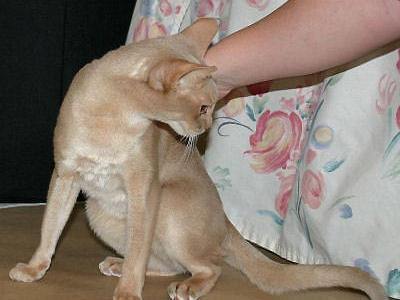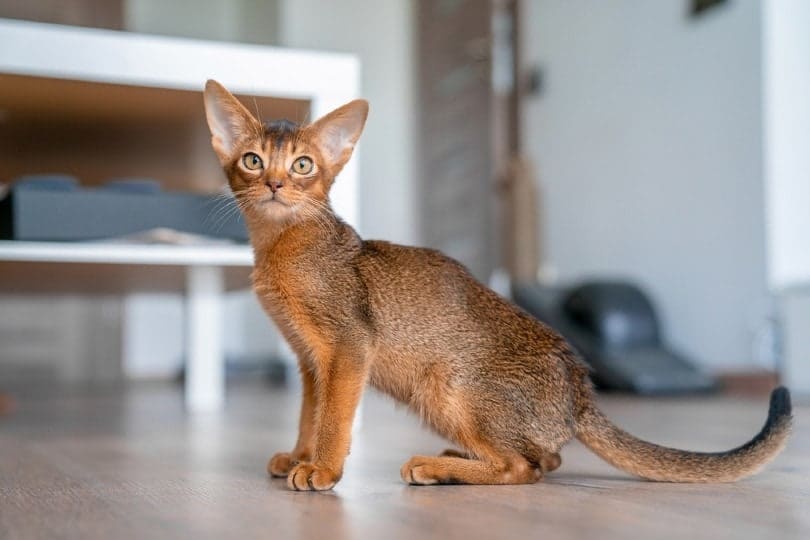
The Abyssinian is lively, affectionate, and low-maintenance… a great pet cat for active people!.
The Abyssinian Cat is ideal for families and active individuals. They are low maintenance, even-tempered cats but are very intelligent and aware of their surroundings. They easily become attached to their owners and enjoy lots of attention. They are affectionate and lively, and like to participate in interactive activities, like fetch. They can even learn some tricks. Although they enjoy playing, they are fairly quiet cats and will usually get along with other pets.
The Abyssinian is a natural breed cat, also known as the Aby Cat and British Tick Cat. It has a slender body, a ticked fur coat, and striking facial features. It is the beautiful ticked, resilient coat that distinguishes them from all other tabby cats. This gives the Abyssinian an interesting, elegant appearance reminiscent of depictions of ancient Egyptian cats. It is because of this that they are thought to be one of the oldest cat breeds.
It is said that they had been brought from Abyssinia (present day Ethiopia) to England by a soldier in the British military. The first recorded Abyssinian was named “Zula.” Some believe that this cat was a direct descendent of the sacred ancient Egyptian cat, Bastet. It is likely that the original cats from Abyssinia were brought to England and were mated with select British Shorthairs to produce the current Abyssinian breed. The Somali is a long-haired version of the Abyssinian. It is recognized as a separate breed, but shares the same ancestors as the Aby Cat.
For information about keeping a pet cat, see:
Cat Care: How to Take Care of a Cat
- Kingdom: Animalia
- Phylum: Chordata
- Class: Mammalia
- Order: Carnivora
- Family: Felidae
- Genus: Felis
- Species: domesticus
Background
Some believe the Abyssinian Cat originated from Ethiopia. They are thought to have been brought from Ethiopia (then Abyssinia) and bred with English species. Some believe they are one of the most ancient of cat breeds, and that they were both companions and gods of the Egyptians. Whether this is true or not, will probably never be known, but the first recorded Abyssinian was a cat named “Zula”, which some believe was a direct descendent of the sacred ancient Egyptian cat, Bastet.
Common names for this natural breed cat include: Abyssinian Cat, Aby Cat, Ticked Cat, British Tick Cat, Rabbit Cat, Hare Cat, and Bunny Cat.
Description
The Abyssinian Cat is a natural breed cat, is most well known for its “ticked” coat. It has various bands of color on each of its hairs, which are short and lie close to the cat’s body. The ticked coat resembles a rabbit’s coat, hence the nicknames “Rabbit Cat”, “Hare Cat”, and “Bunny Cat”.
The Abyssinian is a medium build cat with a long, slender, muscular body. Its weight ranges from 9 to 16 pounds. It has a wedge-shaped head, almond-shaped eyes, large ears, and a long tail. It also has small, compact paws that make it appear as if it is walking on tiptoe. An Abyssinian’s lifespan is about 12 years. Few mutations occur in this species.
 Abyssinian Cat – Tawny Coat Photo © Animal-World: Courtesy Justin Brough
Abyssinian Cat – Tawny Coat Photo © Animal-World: Courtesy Justin BroughAbyssinian Cats come in many different color combinations, but the most prevalent are tawny (usual), cinnamon (sorrel), blue, fawn, and silver. Tawny is a golden brown, ticked with black. Cinnamon is copper ticked with chocolate. Blue is a tawny dilute with pale underparts and blue-gray ticking. Fawn is a dark cream with copper ticking. Silver is another dilute of tawny, with a warm base coat that fades to white.Rare colors include lilac and chocolate.
Glossary terms:
- Ticked Coat: A type of fur coat characteristic of wild rabbits, which is comprised of hair strands with bands of various color.
- Chamois Cloth: A soft, pliant leather cloth made from lamb and sheep skin. Chamois cloth is often used to retain the shine on a cat’s coat.
Care and Feeding
The Aby Cat can benefit from having something they can chew, such as raw chicken necks, in their diet. While they are still growing, they can also benefit from a vitamin supplement.
Housing Your Cat
Abyssinians are active cats, and need room to exercise. Provide them with lots to do, toys and scratch pads to prevent their energy from becoming destructive. It is optimal to provide an enclosed yard for them to play in.
Maintenance
Abyssinians are low-maintenance cats, but can benefit from being brushed weekly. If a shiny coat is desired, rub the coat with a chamois cloth.
Social Behaviors
Abyssinians enjoy being around people and get along with other pets. They are highly intelligent, playful, and loyal. Aby Cats are inquisitive and interested in their surroundings, and love to be involved in family activities. They are good cats for families.
Activities
The Aby Cat enjoys playing and exercising inside and outside. This is an active, inquisitive cat that thrives with interactive play, such as fetch. They are even capable of learning tricks. They need a variety of toys and a scratching post when inside so that they do not turn their extra energy into destructive behavior.
Breeding/Reproduction
These cats are weaned between 12 and 16 weeks.
Common Health Problems
Abyssinians are more susceptible to mild gingivitis than other cat breeds. Gingivitis is an inflammation of the gums and is characterized by a red line of gum tissue on the border against the teeth. It can cause the gums to bleed, and produce larger red areas in more severe cases.
There is no cure for gingivitis in cats. Antibiotics, ant-inflammatory, and immune-suppressive drugs and removal of tarter from the teeth are often used to treat this condition. To prevent gingivitis, owners can feed their cats food intended to prevent dental problems and regularly brush their cats’ teeth.
Availability
An Abyssinian Cat can be purchased from breeders. Some breeders can be found on the internet. Prices range from $350 for a pet to $900 for a show cat.
References
- Animal-World References: Cat Breeds – Exotic Cats
- Don Burke, Abyssinian Cats, Burke’s Backyard, Copyright 2007-2011
- The Abyssinian, Provet:
- Abyssinian, ThinkQuest:
- Desmond Morris, Cat Breeds of the World, Viking Penguin, 1999
Featured Image Credit: Ingus Kruklitis, Shutterstock
